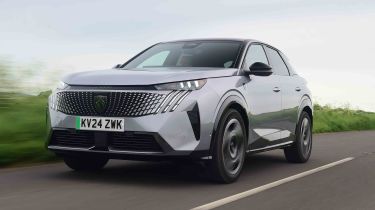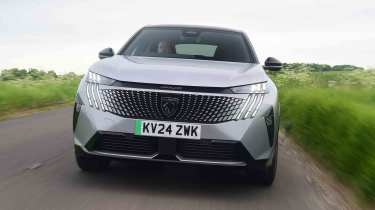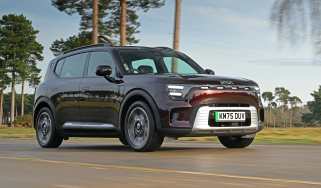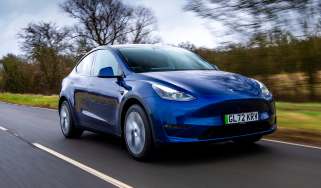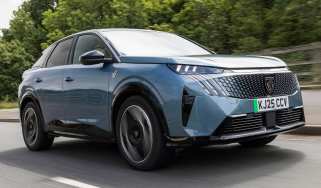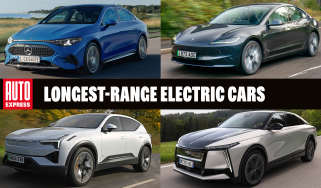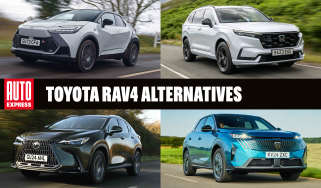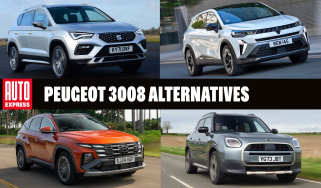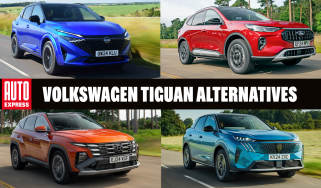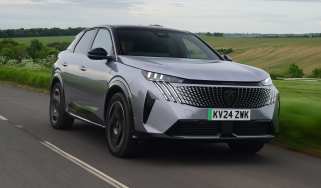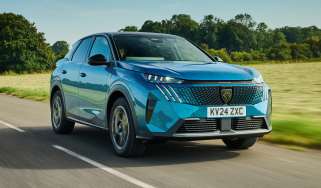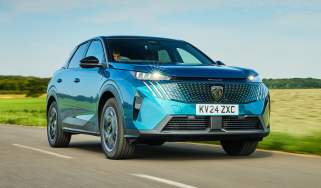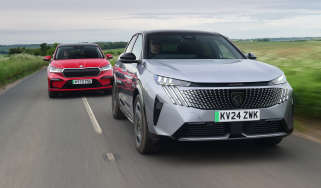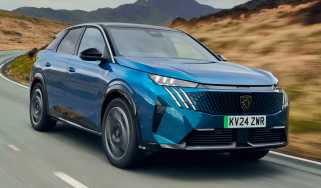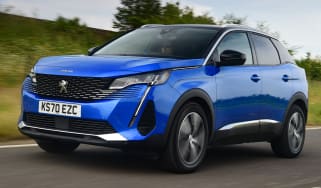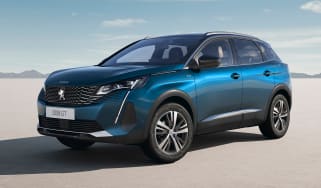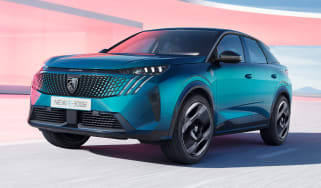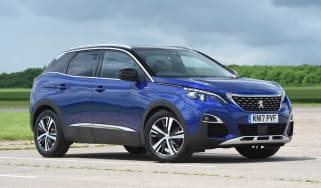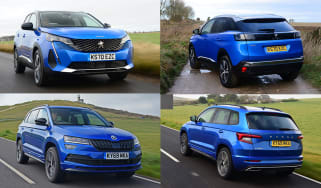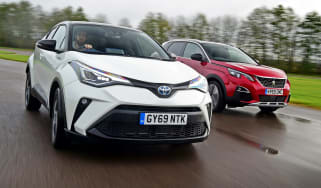Peugeot 3008 review
Our testing of the 3008 uncovered a stylish family SUV that’s better in petrol form and has frustrating tech

Our opinion on the Peugeot 3008
The third-generation Peugeot 3008 has evolved, not just in its looks but also in terms of its technology. You can now get it with a range of modern hybrid and all-electric power to appeal to a wider range of buyers than ever before, from company car drivers looking for low tax bills, to private buyers interested in good fuel economy. It wears a sharper suit than ever before with a rakish, coupe-like profile that's complemented by a dramatic interior that really stands out against rivals in a crowded segment, both for its design and overall quality.
Sadly, the 3008’s driving experience lets it down, with a jiggly ride and steering that lacks the responsiveness of the best around. It also has a frustrating infotainment system that’s distracting to use while on the move, and the E-3008 looks likely to lose its value more quickly than electric SUV rivals.
About the Peugeot 3008
The latest Peugeot 3008 is bigger than a Peugeot 2008, but smaller and sleeker in profile than the seven-seat Peugeot 5008. It can be had in fuel-efficient mild hybrid, plug-in hybrid, or quiet running E-3008 all-electric forms.
It utilises the same platform as the Vauxhall Grandland, although Peugeot’s car sports a far more striking design both inside and out.
Peugeot 3008 prices and latest deals
The Peugeot 3008 is available in two trim levels and one high-end dual-motor electric model with four-wheel drive. Pricing is toward the premium end of the mid-size SUV market with three trim levels on offer:
Used - available now
- Allure (from £38,000)
- GT (from £41,000)
- Dual Motor GT Premium (from £54,500)
Our Find A Car service lets you spec your ideal Peugeot 3008 and select the best offer from top dealers around the UK. Alternatively, you can lease a Peugeot 3008 or buy a used Peugeot 3008. We can help you sell your old car, too.
Performance & driving experience
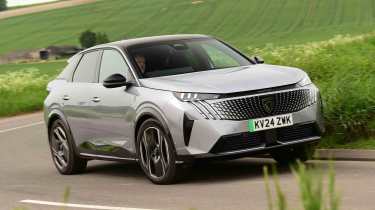
Pros |
|
Cons |
|
The majority of the 3008 range comes with front-wheel drive, while four-wheel drive is reserved for the range-topping Dual Motor version of the electric E-3008. You can add advanced grip control for £300, which has a dedicated drive mode designed to help out in slippery conditions.
The 1.2 Hybrid uses a six-speed automatic gearbox, while the plug-in hybrid has a seven-speed auto. The electric E-3008 has a single-speed configuration like most EVs and is available with three different power outputs and two different battery sizes of 73kWh and 97kWh in capacity.
| Model | Power | 0-62mph | Top speed |
| 1.2 Hybrid Allure | 145bhp | 10.2 seconds | 125mph |
| 1.6 Plug-in hybrid 195 e-DSC7 Allure | 195bhp | 7.8 seconds | 137mph |
| 73kWh 210 Allure | 213bhp | 8.8 seconds | 105mph |
Performance, 0-60mph acceleration and top speed
Once on the move, the 145bhp 1.2 Hybrid provides decent mid-range performance, but its 10.5-second 0-62mph certainly isn’t quick by today’s standards. If you need a bit more get up and go, the 195bhp 1.6 plug-in hybrid manages the same sprint in 7.8 seconds and feels a lot faster.
The electric E-3008 range starts with the 213bhp 210 model, which has a decent 8.8-second 0-62mph time. The extra weight of the 231bhp long range version counteracts the additional power it has, so it’s only marginally quicker with an 8.7-second acceleration time. Finally, the 325bhp dual motor model is the quickest E-3008, with a lively 0-62mph time of 6.0 seconds.
Town driving, visibility and parking
The petrol Peugeot 3008 (particularly on the smaller 19-inch wheels of Allure trim) provides a more tolerable ride than the electric E-3008, which is hampered by a very firm low-speed ride. You feel every facet of the road surface in the electric version, every sunken drain cover, and every impact with potholes.
Some credit should be given to noise isolation, because you don’t hear thuds from the suspension after hitting a bump, and road noise is well subdued. It’s a shame that the 1.2-litre petrol isn’t a bit more refined around town, sounding a little coarse under acceleration for what is supposed to be a premium mid-size family SUV.
The brakes of this mild-hybrid also take some getting used to. During our test drives, we found there’s a long pedal travel and a pronounced switch-over sensation when the system moves between the regenerative braking to the mechanical disc brakes, which robs you of some confidence.
Another annoyance we found with the 1.2-litre is that there’s a significant pause between putting your foot down on the accelerator pedal and the 3008 moving. Now, it isn’t the only modern car we’ve found to be like this, but it’s still something we’d have hoped the small electric motor would have assisted with by giving an initial bump of power off the line that would make merging into gaps in the traffic easier. We also don’t like the lack of an auto-hold function, like you’ll find on a Volkswagen Tiguan, which can hold the car as you transition from the brakes to the accelerator without the vehicle rolling back.
The electric E-3008 also has a slight lag when setting off, but it’s nowhere near as pronounced. Just like the petrol version, there is an obvious transition between regen braking and the mechanical brakes, although you can help the situation by using the steering wheel paddles to adjust the level of regen braking. In its strongest setting, you can do the majority of your slowing down without touching the foot pedal. We’d still like to see a stronger one-pedal drive mode introduced, because you do still have to use the brake pedal to come to a stop below 5mph.
All 3008 and E-3008 models have light steering that makes manoeuvres around town a doddle, although we find the squared shape of the wheel isn’t the best for quickly winding steering lock on when parking.
Country road driving and handling
When we got the E-3008 out of town onto some twisty roads it had a tendency to thud into compressions and there was plenty of side-to-side head toss when going over bumps. It also struggles to contain its near-600kg of extra mass compared with the petrol version over undulations, ultimately feeling a bit unsettled over bumps. The lighter 1.2 version coped better on similar roads, but it still isn’t as comfortable as a Hyundai Tucson would be.
The light steering of this Peugeot, which is quite helpful around town, is less useful at higher speeds. There is a ‘sport’ driving mode, which makes it heavier, but that doesn’t improve the driving experience because we found the steering felt a bit gloopy and imprecise in this mode. Grip levels are high, and there isn’t too much body lean in the bends, so you’re able to confidently carry some speed.
We found it’s worthwhile using the ‘sport’ mode at higher speeds in the E-3008 for better accelerator response, which can be a little lacking in the regular ‘normal’ driving mode beyond 50mph.
Motorway driving and long-distance comfort
Motorways are where the 3008 and E-3008 feel most at home. Refinement is very good and the ride is, generally, settled. Only encounters with potholes and expansion joints upset it.
The test cars we tried had the optional sensation pack, which includes laminated front side windows to reduce the amount of noise caused by wind going over the door mirrors at higher speeds, and we think it certainly helps to lower the amount of disturbance you’ll hear. However, it’s a £1,200 option that’s only available on GT trim cars. While it does also include a nice uprated Focal sound system, we’re not sure it offers the best value for money. Consider it only if you do a lot of motorway miles.
“Electric car fans will be pleased to know that the E-3008 remembers the level of regenerative braking you selected every time you restart the car, rather than reverting to a default setting. I also appreciate that the brake lights come on automatically in the strongest level of regeneration as soon as you lift off the accelerator to warn those behind that you’re slowing down” – Max Adams, online reviews editor
MPG & running costs
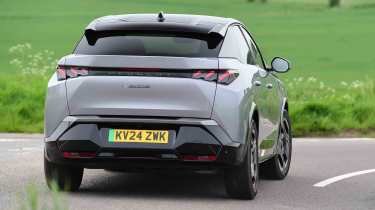
Pros |
|
Cons |
|
The mild-hybrid technology fitted to the 1.2-litre petrol helps it to return a WLTP figure of 52.3mpg, which is significantly up compared with the equivalent mild-hybrid petrol in a VW Tiguan and even the full hybrid Hyundai Tucson.
We’d expect mpg fuel economy in the low to mid forties should be achievable in the real world, given that’s what the same engine in the bigger and slightly heavier Peugeot 5008 achieved on our long-term test fleet.
Company car users who can’t make a full EV work for them will go for the 1.6 plug-in hybrid, which has a WLTP figure of 356.2mpg. We’ve not tried this version yet, but our experience with plug-in hybrid cars suggests you’re unlikely to get near this figure in the real world, even with regular charging.
| Model | MPG | CO2 | Insurance group |
| 1.2 Hybrid Allure | 52.3mpg | 123g/km | 22 |
| 1.6 Plug-in hybrid Allure | 356.2mpg | 19g/km | 32 |
Electric range, battery life and charge time
Our long-term test of an E-3008 yielded an average of 3.9 miles/kWh, while a road test comprising mostly motorway and some spirited driving over the North Yorkshire Moors saw a creditable 3.7 miles/kWh over around 300 miles. We expect that you should be able to achieve around 280 miles from a charge of the 73kWh battery version based on these efficiency figures.
Anyone needing to go further will be looking towards the 435-mile, 97kWh long range E-3008, which is 20kWh and 60 miles more than the largest capacity battery version of the Skoda Enyaq Coupe can manage.
Those likely to use their E-3008 in colder weather should specify the optional heat pump for £700, which is a more reasonable price compared with the Enyaq, where the same thing costs £1,000.
Unfortunately, the E-3008 was a disappointment in our 2025 electric car charging test, because the 73kWh model tested couldn’t reach its peak charging speed of 130kW, only achieving 123kW and even then, only for three minutes. It took nearly 40 minutes to top the battery state of charge up by 60 per cent (Peugeot quotes 30 minutes to top up from 20 to 80 per cent state of charge, the typical amount you might top up by on a long motorway drive). Alternatives like the Hyundai Ioniq 5 or Kia EV6 charge significantly quicker, with a similar top up taking less than 20 minutes on an appropriately quick rapid charger.
We also found that charging is significantly slowed above 80 per cent state of charge, taking 74 minutes to go from 80 to 100 per cent on our 350kW test charger. Our advice is to only top up to 80 per cent when using a rapid charger and then unplug and continue to your next charging stop, if one is needed.
Most EV owners will take advantage of home charging, and a typical 7.4kW wallbox charger will take around 12 hours to fully recharge the 73kWh model, while the 97kWh version will take 15.5 hours to do the same.
We’re yet to try the plug-in hybrid version, but what we can say is that its smaller 21kWh battery (17.9kWh usable) gives over 50 miles of EV range and will take just over five hours to fully recharge using a home wallbox.
| Model | Battery size | Range | Insurance group |
| 73kWh GT | 73kWh | 326 miles | 33 |
| 97kWh Allure Long Range | 97kWh | 435 miles | 33 |
| 73kWh Dual Motor | 73kWh | 303 miles | 40 |
Insurance groups
The petrol 3008 range starts in group 22 for the 1.2 Hybrid, rising to group 32 for the 1.6 plug-in hybrid. Those needing less expensive insurance might want to look at either a Tucson or Tiguan, both of which start in group 18.
The electric E-3008 range also starts in group 32 for the least expensive 73kWh Allure, while the 97kWh long range Allure is in group 33. That’s competitive with the Renault Scenic (group 33-34), but behind the Ford Capri (groups 21-33). The high-performance dual motor model is in group 40.
Tax
The electric E-3008 will be the top choice for company car drivers thanks to a low three per cent benefit-in-kind (BiK). The plug-in hybrid will also be a good choice thanks to its nine per cent BiK rate and over 50 miles of electric range.
Unfortunately, only the Hybrid 145 Allure and GT models drop below the £40,000 luxury car tax threshold once first year vehicle excise duty (VED) and registration costs are subtracted. As a result, the rest of the 3008 and E-3008 line-up is subject to an annual surcharge on top of the standard rate from the second year the vehicle is taxed up until it is six years old.
Depreciation
The regular petrol and plug-in hybrid Peugeot 3008 models are expected to hold on to their value reasonably well compared with rivals, maintaining around 50 per cent of the original sale price after three years or 36,000 miles. That’s a little better than the Nissan Qashqai, which is predicted to maintain 48 to 49 per cent over the same period, but not as good as the Hyundai Tucson, which is expected to retain between 53 and 56 per cent.
In contrast, the electric E-3008 is expected to shed its value quite quickly, only being worth between 32 and 40 per cent of its original value after the same three-year period. That’s in contrast to the Vauxhall Grandland Electric, which is predicted to still be worth 55 to 58 per cent after the same length of time.
Interior, design & technology
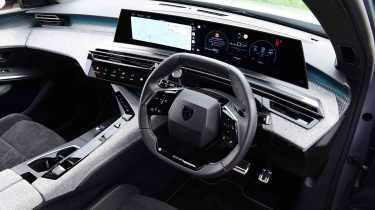
Pros |
|
Cons |
|
Given that there’s already the practical Peugeot 5008 in the range, the 3008 can take on a more svelte look than its predecessor, hence its coupe SUV styling rather than the more boxy lines of its Tiguan and Tucson rivals.
We’re fans of the standard Obsession Blue paint colour, which really shows off the lines of the 3008 in their best light. There are five further colour choices for £750 each, but they don’t stand out quite as well.
Our preferred trim is the entry-level Allure. It comes with all the basics including:
- 19-inch alloy wheels
- 21-inch instrument cluster
- Rear parking sensors
- Sat-nav
- Wireless smartphone charging
We think the £300 AGR Driver’s seat pack and front seat heating is a worthwhile extra to add to Allure trim in order to get heated front seats and lumbar support for the driver’s seat. You may also want to add the £700 360-degree ‘vision and drive assist pack’ to get adaptive cruise control, blindspot monitoring, rear cross traffic alert and a surround view camera system.
Moving up to GT trim adds adaptive cruise control, front parking sensors, an electric tailgate, and heated front seats. It also has adaptive LED headlights for better illumination at night without dazzling oncoming traffic.
The top-of-the-range GT Premium rounds out the range with blind spot monitoring, a 360-degree camera system, heated rear seats, and 10-way electric front seat adjustment with driver's side memory.
Interior and dashboard design
The previous Peugeot 3008 wowed us with its interior design, and the latest second generation 3008 continues to be visually alluring with a swooping dash design and centre console that helps create separate pods for the driver and front seat passenger. A massive 21-inch curved digital display sits atop the dash and links the driver’s instrument cluster to the central touchscreen.
Below the air vents is another touchscreen with the brand’s i-Toggle switches and the gear selector to the right. In our experience, we’re not sure this is the best place for the gear selector because we often reached across to where the drive mode switch is when trying to put the car in ‘drive’ or ‘reverse’.
We particularly like the ambient interior lighting of GT trim, which provides subtle illumination of the dashboard and central storage area at night. It makes it look more like a piece of sculpture than something as mundane as a car dashboard.
Materials and build quality
The areas that you come into contact with regularly in the 3008 look and feel as though they belong in a premium SUV, which is just as well given its price. All versions feature a ‘Graphene’ carbon effect dashboard covering that also extends to the front doors. It’s a lot more visually appealing than the acres of piano black plastic you’ll find in rivals, which is likely to lose its lustre over time, collecting an obvious layer of dust, fingerprints, and scratches. We would warn about being careful with spillages in the 3008 to avoid staining this material, though.

Infotainment, sat-nav and stereo
All versions of 3008 feature the brand’s i-Toggles, which were first introduced on the smaller Peugeot 308, and comprise a row of customisable shortcuts on a thin digital touchscreen to help when navigating the infotainment system.
Unfortunately, the infotainment of the 3008 ranked ninth out of the 10 systems tested as part of our test of car infotainment systems. It proved to be one of the more distracting systems to use, with slow response times and a more cluttered menu layout than less perplexing rivals. It’s just not as easy to use as the one you’ll find in the Tiguan or Skoda Enyaq Coupe.
The system has also proven to be glitchy at times, with all the screens in the Peugeot 5008 we ran on a long-term test (which uses the same infotainment system) going blank a few times while driving. The solution is a hard reboot (stopping and switching the car off and on again) in order to restart the screens.
A 10-speaker, 690-watt Focal sound system is available on GT and GT Premium trims as part of the pricey £1,200 Sensation Pack.
“I found that the infotainment system kept dropping its wireless Android Auto connection during one journey, despite it being fine for the days up to that point. It was quite happy, however, when I switched to an iOS phone and used Apple CarPlay instead.” – Max Adams, online reviews editor
Boot space & practicality
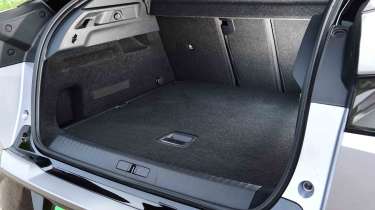
Pros |
|
Cons |
|
The latest 3008 takes on a more sporting coupe-like stance similar to the Peugeot 408 to differentiate itself from the larger and more versatile seven-seat Peugeot 5008
There’s 34-litres of hidden storage space in the front of the 3008, with the majority of this coming from two big compartments within the centre console. The one underneath the armrest is easily accessible to both front seat occupants, but the driver has to reach over the console to get to the one that houses the two USB-C charging ports, so this is easier for the front seat passenger to get to. The glovebox is bigger on left-hand drive cars because the fuse box hasn’t been moved for the right-hand drive cars we get in the UK, cutting into the available space.
We do like the fact that the door bins are lined like you’ll find on a VW Tiguan because that means small items are less likely to rattle in them.
Dimensions and size
The latest 3008 sits between the Tucson and Tiguan in terms of length. It’s not as tall as those rivals, highlighting its coupe-like styling. The 3008 has a longer wheelbase and is wider than both of those competitors, which should make it more spacious inside – although our measurements suggest otherwise.
| Dimensions comparison | |||
| Model | Peugeot 3008 | Hyundai Tucson | Volkswagen Tiguan |
| Length | 4,542mm | 4,570mm | 4,539mm |
| Width | 1,895mm | 1,865mm | 1,842mm |
| Height | 1,641mm | 1,650mm | 1,658mm |
| Wheelbase | 2,739mm | 2,680mm | 2,677mm |
| Boot space | 588 litres | 616 litres (577 litres for hybrid and PHEV) | 652 litres (490 litres PHEV) |
Seats & passenger space
The Peugeot i-Cockpit design continues in the latest 3008, and while some of our testers got on with its small, squared-off steering wheel that you have to look over in order to see the driver’s side digital instrument cluster, others still found that the wheel cut off the view of the display. Our advice is still to try it to find out if it works for you before buying.
The driving position is reasonably high up and gives a good view forward. There’s plenty of adjustment in the seats and steering wheel of a 5ft 11in driver to get comfortable, although it’s a shame that lumbar adjustment isn’t standard until you go for the pricier GT trim (is available as a £300 option on Allure), and there’s no seatbelt height adjustment for differing sizes of driver. Electric adjustment with memory settings for the driver’s seat is standard on GT Premium, or as an option with the £1,000 mistral black Alcantara trim on GT cars. It's also annoying that there's no rear windscreen wiper to improve rear visibility when it's raining. It'll only clear the screen with the flow of air at motorway speeds, which isn't especially useful if you're trundling around town.
In our testing, a 5ft 11in adult could fit in the back seats behind their driving position, although their head was just touching the roof lining. Our kneeroom measurements for the back seats of the 3008 are 594 minimum and 848mm maximum. That’s a decent amount, but our figures show that the both the Tucson (629 - 844mm) and Tiguan (625 - 868mm) offer more space overall. For those who regularly carry taller people in the rear, the more spacious Peugeot 5008 might be a better bet.
On the plus side, the front seats of the 3008 are high enough off the floor to allow those in the back to slide their feet underneath (in this case, wearing size 11 shoes), giving them a chance to stretch out. The 3008 has a flat floor, meaning the middle seat occupant doesn’t need to straddle a large lump in the floor.
A pair of Isofix child seat mounting points are provided on the outer positions of the rear bench, but they’re fiddly to access behind some zips unlike the easily removable plastic covers of a Tiguan or Enyaq Coupe. On GT trim models, a central armrest containing a pair of cupholders that’ll take a regular-sized bottle of water is standard.
Boot space
A family should have no issues with the 588-litre boot, which is handily the same size whether you go for the petrol, plug-in hybrid, or fully electric versions of the 3008. Its uniform shape makes packing easier, and various hooks and straps are provided to keep items in place. There’s also a 12V power outlet should you wish to plug in something like a cool box.
The only downside is that due to its coupe-esque outline, more traditionally shaped rivals like the Hyundai Tucson and VW Tiguan have more boot capacity, at 616 litres and 652 litres, respectively.
The rear seats fold in a 40:20:40 split, which is the same as a Tucson and more versatile than rivals like the Tiguan that only have a 60:40 split. There’s no awkward lump in the floor of the 3008 when the seats are folded down, and only a slight incline in the floor to push longer items up. Total volume is 1,663 litres, which is slightly more than a Tiguan, but behind the 1,795 litre Tucson.
Towing
Towing capacity for the 3008 isn’t particularly outstanding for the class, with the best being the 1,550kg rating for the plug-in hybrid. The petrol only manages 1,200kg, which is significantly down on the 1,600kg of the least capable 1.5 eTSI 130 Volkswagen Tiguan.
For anyone looking at an electric tow vehicle, the best E-3008 is the 1,350kg rating for the dual-motor model, while the long range 97kWh models decrease this to 1,200kg. Neither is all that impressive against the 1,800kg a Kia EV6 can lug around.
“I appreciate that Peugeot has copied VW by providing a latch that holds the boot floor up when accessing the large underfloor storage area, which is easily large enough to store the charging cables of plug-in hybrid and electric models.” – Max Adams, online reviews editor
Reliability & safety
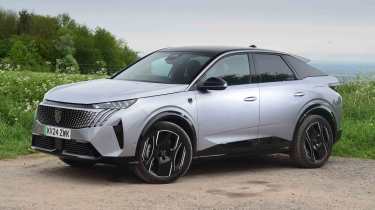
Pros |
|
Cons |
|
The Peugeot brand managed to place seventh out of 31 manufacturers in the 2025 Driver Power customer satisfaction survey. Owners praised the exterior styling, handling, steering, and interiors of their cars most of all, but weren’t so happy with value for money.
All versions of the 3008 come with a three-year/60,000-mile manufacturer warranty, although that isn’t very impressive given Hyundai has a five-year/unlimited mileage warranty.
The electric E-3008 get an eight-year/100,000-mile warranty for the battery pack, and if you stick with main dealer servicing, you’ll qualify for the brand’s Allure Care extended warranty package that also covers the electric motor and charging system beyond the standard manufacturer’s warranty period up to eight years or 100,000 miles.
Its four-star Euro NCAP safety rating is a little disappointing for a family car given that rivals like the Ford Capri and Volkswagen Tiguan that were tested under the same criteria got the maximum five-star rating.
| Euro NCAP safety ratings | |
| Euro NCAP safety rating | 4-stars (NCAP, 2025) |
| Adult occupant protection | 80% |
| Child occupant protection | 85% |
| Vulnerable road user protection | 79% |
| Safety assist | 62% |
Buying and owning
Best buy: Peugeot 3008 1.2 Hybrid Allure
Despite its hesitation around town, we think the least expensive 1.2 Hybrid Allure makes the most sense because it’s well equipped and keeps the price below the £40,000 luxury car tax surcharge.
If you’re planning on going electric, you’ll be better off sticking with the least expensive Allure trim and perhaps adding the £700 heat pump option to better preserve your driving range over colder winter months. The 73kWh model should cover most of your driving needs and saves you a decent amount of money compared with the 97kWh long range E-3008 version.
Peugeot 3008 alternatives
The French brand’s push upmarket means that the 3008 is more in-line with typical premium mid-size SUV like the Volkswagen Tiguan in terms of price compared with the much more affordable Citroen C5 Aircross or Dacia Bigster.
While it isn’t as good looking, the Tiguan is a good all-rounder with better practicality, easier-to-use infotainment, and a smoother petrol engine. It is available in plug-in hybrid form with around 10 more miles of electric range.
Another good alternative is the Hyundai Tucson, which has been an Auto Express award winner on multiple occasions. It’s nicer to drive, and is stacked with equipment, despite undercutting the 3008 on price.
Electric alternatives to the E-3008 include the Skoda Enyaq Coupe (which is more in keeping with the coupe styling of this Peugeot), or, if you can go for something a little less stylish, the Vauxhall Grandland Electric uses the same underpinnings as the E-3008, but costs significantly less. Thanks to a starting price well below £40,000, it not only avoids the luxury car surcharge, but also qualifies for the electric car discount, helping make it even more affordable.
Key updates of the Peugeot 3008 review
22 December 2025: Updated the depreciation section and included the GT Premium trim in the interior section.
Deals on the Peugeot 3008 and alternatives
Peugeot 3008 pictures
Frequently Asked Questions
The Peugeot 3008 comes with a two-year/unlimited mileage warranty from Peugeot, with an extra year of coverage provided by the dealer up to a maximum of 60,000 miles.
